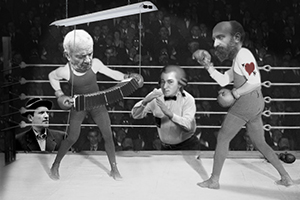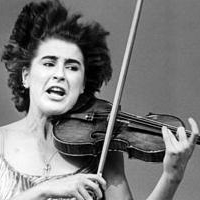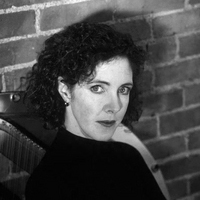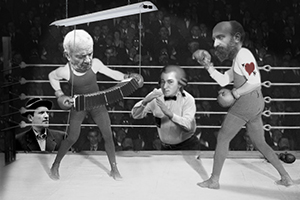
Wednesday’s New Century Chamber Orchestra program, at San Francisco’s Herbst Theatre, was not for the faint of heart. Music Director Nadja Salerno-Sonnenberg pulled no punches in dramatizing Osvaldo Golijov’s Last Round, the first movement of which is supposed to represent both a boxing match (between two separated string quartets and a string bass “referee”) and the forceful compression of the bandoneon, tango-master Astor Piazzolla’s favorite accordionlike instrument.
As Golijov said about his 1996 composition, “The piece represents an imaginary chance for Piazzolla’s spirit to fight one more time (he got into fistfights throughout his life).” The first movement, “Movido, urgente” (rough, restless, choppy; urgent), accordingly features slashing bow glissandos from alternating sides of the stage. The bass in the middle keeps up a relentless pace until a last glissando wheezes out like an expiring breath. There’s an immediate segue into a slow tango-dirge that Golijov likened to “a final, seemingly endless opening sigh” in Piazzolla’s remembrance. In it, there’s a heartfelt fantasy on Carlos Gardel’s song, My Beloved Buenos Aires.

Brilliantly realized by Salerno-Sonnenberg and her crew, Last Round, despite its subject matter, was surprisingly not a big hit with the audience: There were few cheers and only one or two standees. Some folks I chatted with found it ugly, too dissonant, even offensive. Are San Franciscans overly pacifist?
Golijov’s music generated strong emotions — the perfect time to call a timeout for a cooling-off period. Mozart, everybody’s favorite feel-good composer, was just the ticket. Anne-Marie McDermott, a pianist highly active on the touring scene, and a former accompanist of Salerno-Sonnenberg’s, emerged to salve through the Piano Concerto No. 12 in A Major, K. 414, of 1782. A fine rendition indeed was forthcoming, as McDermott proved to be a master of accent, as well as of grading dynamics to match the musical line. Mozart’s music can sound simple, yet its transparency calls for the utmost in precision and clarity. These qualities McDermott had in spades, except for two ever-so-slightly blurred runs in the first movement. The performance was simply a joy to hear.
Nice-lady-from-Mozartland McDermott turned ferocious in this piece: She and Salerno-Sonnenberg dominated the proceedings.
After intermission it was time to open the emotional floodgates again. Ernest Chausson’s Concerto for Piano, Violin, and String Quartet, Op. 21, puts the soul through the wringer in three of its four movements. Much influenced by the chromaticism of Wagner and Franck, the music at times makes Tristan sound like merely a journal on puppy love, with more dynamic and harmonic gushings than a Saint Sebastian painting has arrows.

Nice-lady-from-Mozartland McDermott turned ferocious in this piece: She and Salerno-Sonnenberg dominated the proceedings. With 14 supporting musicians, they were able to fully wrench home the climaxes, especially the almost unbearably intense one that crowns the third (Grave) movement.
I was impressed, then exhausted, and finally realized why some have speculated that Chausson’s solitary death on a bicycle at age 44 (he crashed into a brick wall) might have been a suicide: heart too much on-sleeve to bear?
May the NCCO stay away from bicycles and bricks, and continue to shine light on fabulous, even dangerous repertoire.

